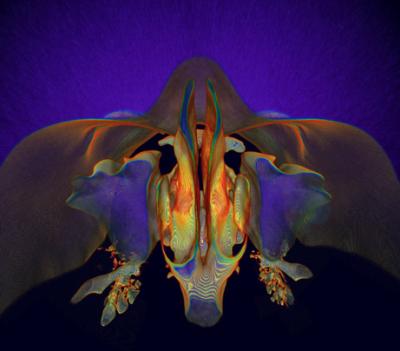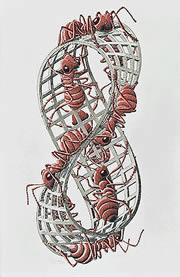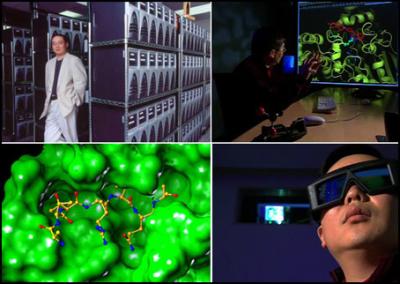Topic: SCIENCE - on October 30, 2007 at 12:59:00 PM CET
Key HIV strain 'came from Haiti'
The strain of the HIV virus which predominates in the United States and Europe has been traced back to Haiti by an international team of scientists.
The strain passed from Haiti to the US in about 1969 before spreading further, says the team in the Proceedings of the US National Academy of Sciences.
... Link (0 comments) ... Comment
Topic: SCIENCE - on October 18, 2007 at 12:31:00 PM CEST
Astrophysicist Replaces Supercomputer with Eight PlayStation 3s
Suffering from its exorbitant price point and a dearth of titles, Sony's PlayStation 3 isn't exactly the most popular gaming platform on the block. But while the console flounders in the commercial space, the PS3 may be finding a new calling in the realm of science and research.
Right now, a cluster of eight interlinked PS3s is busy solving a celestial mystery involving gravitational waves and what happens when a super-massive black hole, about a million times the mass of our own sun, swallows up a star.
... Link (0 comments) ... Comment
Topic: SCIENCE - on October 2, 2007 at 10:09:00 AM CEST
Scientists Invent 30 Year Continuous Power Laptop Battery [Hoax]
Your next laptop could have a continuous power battery that lasts for 30 years without a single recharge thanks to work being funded by the U.S. Air Force Research Laboratory. The breakthrough betavoltaic power cells are constructed from semiconductors and use radioisotopes as the energy source. As the radioactive material decays it emits beta particles that transform into electric power capable of fueling an electrical device like a laptop for years.
... Link (0 comments) ... Comment
Topic: SCIENCE - on September 28, 2007 at 11:11:00 AM CEST
Best Science Images of 2007 Honored
A striking image of seaweed shows the complexity of even the simplest organisms.
Seen here is Irish moss—Chondrus crispus—a common Atlantic red alga that is routinely harvested for its carrageenan. The chemical is used as a thickener in many processed foods.

... Link (0 comments) ... Comment
Topic: SCIENCE - on August 22, 2007 at 1:50:00 PM CEST
Egypt footprint 'could be oldest'
Archaeologists in Egypt say they have discovered what might be the oldest human footprint ever found.
The outline was found imprinted in mud, which has since turned to stone, at Siwa oasis in the western desert.
"This could go back about two million years," antiquities council chief Zahi Hawass was quoted by Reuters as saying.
... Link (0 comments) ... Comment
Topic: SCIENCE - on August 20, 2007 at 3:22:00 PM CEST
Scientists hail ‘frozen smoke’ as material that will change world
A MIRACLE material for the 21st century could protect your home against bomb blasts, mop up oil spillages and even help man to fly to Mars.
Aerogel, one of the world’s lightest solids, can withstand a direct blast of 1kg of dynamite and protect against heat from a blowtorch at more than 1,300C.
... Link (0 comments) ... Comment
Topic: SCIENCE - on August 16, 2007 at 11:44:00 AM CEST
We have broken speed of light
A pair of German physicists claims to have broken the speed of light - an achievement that would undermine our entire understanding of space and time.
According to Einstein's special theory of relativity, it would require an infinite amount of energy to propel an object at more than 186,000 miles (300,000 km) per second.
... Link (0 comments) ... Comment
Topic: SCIENCE - on July 27, 2007 at 9:58:00 AM CEST
Newsflash: Time May Not Exist
No one keeps track of time better than Ferenc Krausz. In his lab at the Max Planck Institute of Quantum Optics in Garching, Germany, he has clocked the shortest time intervals ever observed. Krausz uses ultraviolet laser pulses to track the absurdly brief quantum leaps of electrons within atoms. The events he probes last for about 100 attoseconds, or 100 quintillionths of a second. For a little perspective, 100 attoseconds is to one second as a second is to 300 million years.
... Link (0 comments) ... Comment
Topic: SCIENCE - on July 18, 2007 at 11:16:00 AM CEST
The 7 Most Exciting Moments in Science...according to Discover Magazine
One of science’s most well loved stories is that of Archimedes, fresh from discovering the principle of buoyancy during a bath, running naked through the streets of Syracuse yelling “Eureka!” (“I have found it!”) Unfortunately, the story, told for the first time two centuries after Archimedes’ death, is hogwash. Myths like this one sometimes make it seem that science moves along in a series of epiphanies, hopping from one transcendent moment to another.
In reality, science generally pushes forward with all the alacrity of tectonic plates, painstakingly testing and disproving theories until new laws emerge.
... Link (0 comments) ... Comment
Topic: SCIENCE - on July 18, 2007 at 10:46:00 AM CEST
Möbius strip unravelled
Mathematicians solve 75-year-old mystery of infinite loop's shape.
Eugene Starostin's desk is littered with rectangular pieces of paper. He picks one up, twists it, and joins the two ends with a pin. The resulting shape has a beautiful simplicity to it — the mathematical symbol for infinity (infinity) in three-dimensional form. "Look," he says, as he traces his finger along its side, "whatever path you take, you always end up where you started."
Discovered independently by two German mathematicians in 1858 — but named after just one of them — the Möbius strip has beguiled artists, illuminated science lessons and stubbornly resisted definition.

... Link (0 comments) ... Comment
Topic: SCIENCE - on June 14, 2007 at 11:07:00 AM CEST
The Best Thought Experiments: Schrodinger's Cat, Borel's Monkeys
1. Galileo's balls 2. Schrödinger's cat 3. Searle's room 4. Hawking's turtles 5. Einstein's light beam 6. Borel's monkeys 7. Maxwell's demon 8. Parfit's teleporter

... Link (0 comments) ... Comment
Topic: SCIENCE - on June 4, 2007 at 11:07:00 AM CEST
Visualizing the Molecules that Cause Infectious Disease: Seeing with Supercomputers
Star Trek's "holodeck" has nothing on the visualizations of Mayo Clinic chemist, Dr. Yuan-Ping Pang. While the 3-D holographic chamber on the starship Enterprise projected imaginary interactive images, those of Dr. Pang's lab are all very real. They are scientific visualizations of molecules that cause infectious diseases; he creates them to show researchers what their quarry looks like. In this dimension of inner space, he is going where no one has gone before.

... Link (0 comments) ... Comment










